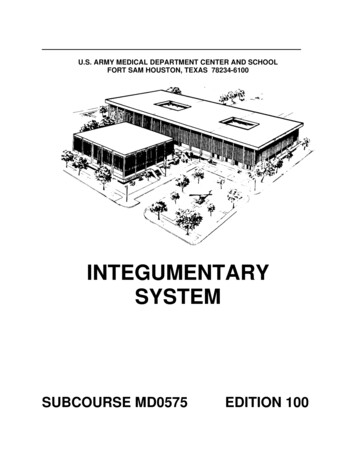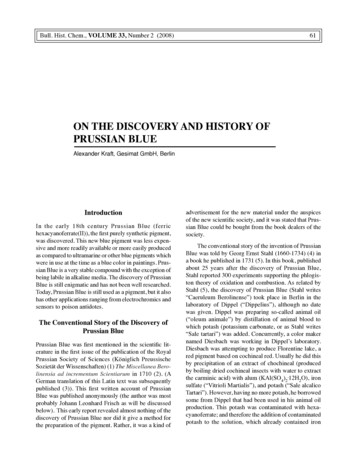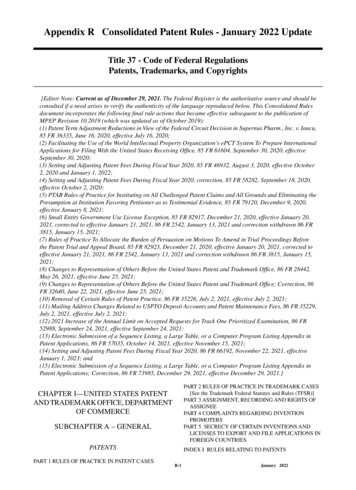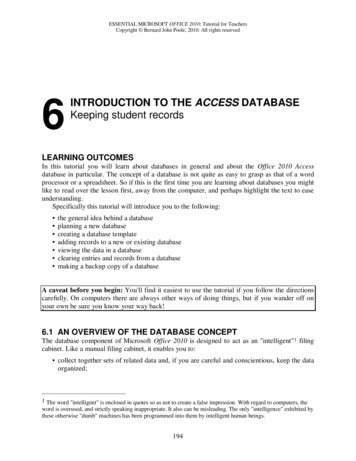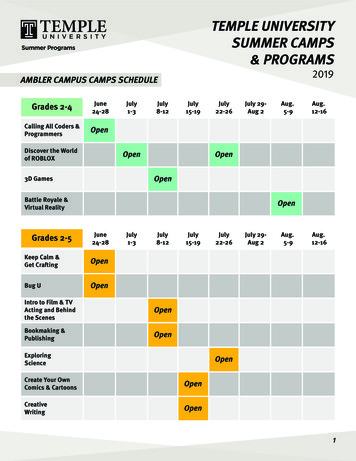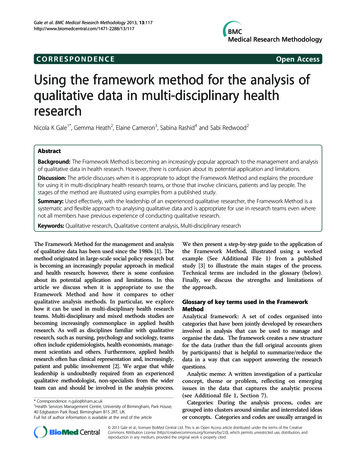
Transcription
Gale et al. BMC Medical Research Methodology 2013, 7CORRESPONDENCEOpen AccessUsing the framework method for the analysis ofqualitative data in multi-disciplinary healthresearchNicola K Gale1*, Gemma Heath2, Elaine Cameron3, Sabina Rashid4 and Sabi Redwood2AbstractBackground: The Framework Method is becoming an increasingly popular approach to the management and analysisof qualitative data in health research. However, there is confusion about its potential application and limitations.Discussion: The article discusses when it is appropriate to adopt the Framework Method and explains the procedurefor using it in multi-disciplinary health research teams, or those that involve clinicians, patients and lay people. Thestages of the method are illustrated using examples from a published study.Summary: Used effectively, with the leadership of an experienced qualitative researcher, the Framework Method is asystematic and flexible approach to analysing qualitative data and is appropriate for use in research teams even wherenot all members have previous experience of conducting qualitative research.Keywords: Qualitative research, Qualitative content analysis, Multi-disciplinary researchThe Framework Method for the management and analysisof qualitative data has been used since the 1980s [1]. Themethod originated in large-scale social policy research butis becoming an increasingly popular approach in medicaland health research; however, there is some confusionabout its potential application and limitations. In thisarticle we discuss when it is appropriate to use theFramework Method and how it compares to otherqualitative analysis methods. In particular, we explorehow it can be used in multi-disciplinary health researchteams. Multi-disciplinary and mixed methods studies arebecoming increasingly commonplace in applied healthresearch. As well as disciplines familiar with qualitativeresearch, such as nursing, psychology and sociology, teamsoften include epidemiologists, health economists, management scientists and others. Furthermore, applied healthresearch often has clinical representation and, increasingly,patient and public involvement [2]. We argue that whileleadership is undoubtedly required from an experiencedqualitative methodologist, non-specialists from the widerteam can and should be involved in the analysis process.* Correspondence: n.gale@bham.ac.uk1Health Services Management Centre, University of Birmingham, Park House,40 Edgbaston Park Road, Birmingham B15 2RT, UKFull list of author information is available at the end of the articleWe then present a step-by-step guide to the application ofthe Framework Method, illustrated using a workedexample (See Additional File 1) from a publishedstudy [3] to illustrate the main stages of the process.Technical terms are included in the glossary (below).Finally, we discuss the strengths and limitations ofthe approach.Glossary of key terms used in the FrameworkMethodAnalytical framework: A set of codes organised intocategories that have been jointly developed by researchersinvolved in analysis that can be used to manage andorganise the data. The framework creates a new structurefor the data (rather than the full original accounts givenby participants) that is helpful to summarize/reduce thedata in a way that can support answering the researchquestions.Analytic memo: A written investigation of a particularconcept, theme or problem, reflecting on emergingissues in the data that captures the analytic process(see Additional file 1, Section 7).Categories: During the analysis process, codes aregrouped into clusters around similar and interrelated ideasor concepts. Categories and codes are usually arranged in 2013 Gale et al.; licensee BioMed Central Ltd. This is an Open Access article distributed under the terms of the CreativeCommons Attribution License (http://creativecommons.org/licenses/by/2.0), which permits unrestricted use, distribution, andreproduction in any medium, provided the original work is properly cited.
Gale et al. BMC Medical Research Methodology 2013, 7a tree diagram structure in the analytical framework.While categories are closely and explicitly linked to theraw data, developing categories is a way to start theprocess of abstraction of the data (i.e. towards the generalrather than the specific or anecdotal).Charting: Entering summarized data into the FrameworkMethod matrix (see Additional File 1, Section 6).Code: A descriptive or conceptual label that is assignedto excerpts of raw data in a process called ‘coding’(see Additional File 1, Section 3).Data: Qualitative data usually needs to be in textual formbefore analysis. These texts can either be elicited texts(written specifically for the research, such as food diaries),or extant texts (pre-existing texts, such as meetingminutes, policy documents or weblogs), or can be producedby transcribing interview or focus group data, or creating‘field’ notes while conducting participant-observation orobserving objects or social situations.Indexing: The systematic application of codes fromthe agreed analytical framework to the whole dataset(see Additional File 1, Section 5).Matrix: A spreadsheet contains numerous cells intowhich summarized data are entered by codes (columns)and cases (rows) (see Additional File 1, Section 6).Themes: Interpretive concepts or propositions thatdescribe or explain aspects of the data, which are thefinal output of the analysis of the whole dataset. Themesare articulated and developed by interrogating datacategories through comparison between and withincases. Usually a number of categories would fallunder each theme or sub-theme [3].Transcript: A written verbatim (word-for-word) accountof a verbal interaction, such as an interview or conversation.BackgroundThe Framework Method sits within a broad family ofanalysis methods often termed thematic analysis orqualitative content analysis. These approaches identifycommonalities and differences in qualitative data, beforefocusing on relationships between different parts ofthe data, thereby seeking to draw descriptive and/orexplanatory conclusions clustered around themes. TheFramework Method was developed by researchers,Jane Ritchie and Liz Spencer, from the Qualitative ResearchUnit at the National Centre for Social Research in theUnited Kingdom in the late 1980s for use in large-scalepolicy research [1]. It is now used widely in other areas,including health research [3-12]. Its defining feature is thematrix output: rows (cases), columns (codes) and ‘cells’ ofsummarised data, providing a structure into which theresearcher can systematically reduce the data, in orderto analyse it by case and by code [1]. Most often a‘case’ is an individual interviewee, but this can beadapted to other units of analysis, such as predefinedPage 2 of 8groups or organisations. While in-depth analyses of keythemes can take place across the whole data set, the viewsof each research participant remain connected to otheraspects of their account within the matrix so that thecontext of the individual’s views is not lost. Comparingand contrasting data is vital to qualitative analysis and theability to compare with ease data across cases as well aswithin individual cases is built into the structure andprocess of the Framework Method.The Framework Method provides clear steps to followand produces highly structured outputs of summariseddata. It is therefore useful where multiple researchers areworking on a project, particularly in multi-disciplinaryresearch teams were not all members have experienceof qualitative data analysis, and for managing largedata sets where obtaining a holistic, descriptive overviewof the entire data set is desirable. However, caution isrecommended before selecting the method as it is not asuitable tool for analysing all types of qualitative data orfor answering all qualitative research questions, nor is itan ‘easy’ version of qualitative research for quantitativeresearchers. Importantly, the Framework Method cannotaccommodate highly heterogeneous data, i.e. data mustcover similar topics or key issues so that it is possible tocategorize it. Individual interviewees may, of course, havevery different views or experiences in relation to eachtopic, which can then be compared and contrasted. TheFramework Method is most commonly used for thethematic analysis of semi-structured interview transcripts,which is what we focus on in this article, although it could,in principle, be adapted for other types of textual data[13], including documents, such as meeting minutes ordiaries [12], or field notes from observations [10].For quantitative researchers working with qualitativecolleagues or when exploring qualitative research for thefirst time, the nature of the Framework Method is seductivebecause its methodical processes and ‘spreadsheet’approach seem more closely aligned to the quantitativeparadigm [14]. Although the Framework Method is a highlysystematic method of categorizing and organizing whatmay seem like unwieldy qualitative data, it is not a panaceafor problematic issues commonly associated with qualitative data analysis such as how to make analytic choices andmake interpretive strategies visible and auditable. Qualitative research skills are required to appropriately interpretthe matrix, and facilitate the generation of descriptions,categories, explanations and typologies. Moreover, reflexivity, rigour and quality are issues that are requisite in theFramework Method just as they are in other qualitativemethods. It is therefore essential that studies using theFramework Method for analysis are overseen by an experienced qualitative researcher, though this does not precludethose new to qualitative research from contributing to theanalysis as part of a wider research team.
Gale et al. BMC Medical Research Methodology 2013, 7There are a number of approaches to qualitative dataanalysis, including those that pay close attention to languageand how it is being used in social interaction such asdiscourse analysis [15] and ethnomethodology [16]; thosethat are concerned with experience, meaning and languagesuch as phenomenology [17,18] and narrative methods [19];and those that seek to develop theory derived from datathrough a set of procedures and interconnected stages suchas Grounded Theory [20,21]. Many of these approaches areassociated with specific disciplines and are underpinned byphilosophical ideas which shape the process of analysis [22].The Framework Method, however, is not aligned witha particular epistemological, philosophical, or theoreticalapproach. Rather it is a flexible tool that can be adaptedfor use with many qualitative approaches that aim togenerate themes.The development of themes is a common feature ofqualitative data analysis, involving the systematic searchfor patterns to generate full descriptions capable ofshedding light on the phenomenon under investigation. Inparticular, many qualitative approaches use the ‘constantcomparative method’, developed as part of GroundedTheory, which involves making systematic comparisonsacross cases to refine each theme [21,23]. Unlike GroundedTheory, the Framework Method is not necessarily concerned with generating social theory, but can greatlyfacilitate constant comparative techniques through thereview of data across the matrix.Perhaps because the Framework Method is so obviouslysystematic, it has often, as other commentators have noted,been conflated with a deductive approach to qualitativeanalysis [13,14]. However, the tool itself has no allegianceto either inductive or deductive thematic analysis; wherethe research sits along this inductive-deductive continuumdepends on the research question. A question such as, ‘Canpatients give an accurate biomedical account of theonset of their cardiovascular disease?’ is essentially ayes/no question (although it may be nuanced by the extentof their account or by appropriate use of terminology) andso requires a deductive approach to both data collectionand analysis (e.g. structured or semi-structured interviewsand directed qualitative content analysis [24]). Similarly, adeductive approach may be taken if basing analysis on apre-existing theory, such as behaviour change theories, forexample in the case of a research question such as ‘Howdoes the Theory of Planned Behaviour help explain GPprescribing?’ [11]. However, a research question such as,‘How do people construct accounts of the onset of theircardiovascular disease?’ would require a more inductiveapproach that allows for the unexpected, and permits moresocially-located responses [25] from interviewees that mayinclude matters of cultural beliefs, habits of food preparation, concepts of ‘fate’, or links to other important eventsin their lives, such as grief, which cannot be predicted byPage 3 of 8the researcher in advance (e.g. an interviewee-led openended interview and grounded theory [20]). In all thesecases, it may be appropriate to use the Framework Methodto manage the data. The difference would becomeapparent in how themes are selected: in the deductiveapproach, themes and codes are pre-selected based onprevious literature, previous theories or the specificsof the research question; whereas in the inductiveapproach, themes are generated from the data thoughopen (unrestricted) coding, followed by refinement ofthemes. In many cases, a combined approach is appropriatewhen the project has some specific issues to explore, butalso aims to leave space to discover other unexpectedaspects of the participants’ experience or the way theyassign meaning to phenomena. In sum, the FrameworkMethod can be adapted for use with deductive, inductive, orcombined types of qualitative analysis. However, there aresome research questions where analysing data by case andtheme is not appropriate and so the Framework Methodshould be avoided. For instance, depending on the researchquestion, life history data might be better analysed usingnarrative analysis [19]; recorded consultations betweenpatients and their healthcare practitioners using conversation analysis [26]; and documentary data, such as resourcesfor pregnant women, using discourse analysis [27].It is not within the scope of this paper to considerstudy design or data collection in any depth, but beforemoving on to describe the Framework Method analysisprocess, it is worth taking a step back to consider brieflywhat needs to happen before analysis begins. The selectionof analysis method should have been considered at theproposal stage of the research and should fit with theresearch questions and overall aims of the study. Manyqualitative studies, particularly ones using inductive analysis, are emergent in nature; this can be a challenge andthe researchers can only provide an “imaginative rehearsal”of what is to come [28]. In mixed methods studies, the roleof the qualitative component within the wider goals of theproject must also be considered. In the data collectionstage, resources must be allocated for properly trainedresearchers to conduct the qualitative interviewing becauseit is a highly skilled activity. In some cases, a research teammay decide that they would like to use lay people, patientsor peers to do the interviews [29-32] and in this case theymust be properly trained and mentored which requirestime and resources. At this early stage it is also useful toconsider whether the team will use Computer AssistedQualitative Data Analysis Software (CAQDAS), which canassist with data management and analysis.As any form of qualitative or quantitative analysis isnot a purely technical process, but influenced by thecharacteristics of the researchers and their disciplinaryparadigms, critical reflection throughout the researchprocess is paramount, including in the design of the
Gale et al. BMC Medical Research Methodology 2013, 7study, the construction or collection of data, and theanalysis. All members of the team should keep a researchdiary, where they record reflexive notes, impressions of thedata and thoughts about analysis throughout the process.Experienced qualitative researchers become more skilled atsifting through data and analysing it in a rigorous andreflexive way. They cannot be too attached to certainty, butmust remain flexible and adaptive throughout the researchin order to generate rich and nuanced findings thatembrace and explain the complexity of real social life andcan be applied to complex social issues. It is important toremember when using the Framework Method that, unlikequantitative research where data collection and data analysis are strictly sequential and mutually exclusive stages ofthe research process, in qualitative analysis there is, to agreater or lesser extent depending on the project, ongoinginterplay between data collection, analysis, and theorydevelopment. For example, new ideas or insights fromparticipants may suggest potentially fruitful lines of enquiry,or close analysis might reveal subtle inconsistencies in anaccount which require further exploration.Procedure for analysisStage 1: TranscriptionA good quality audio recording and, ideally, a verbatim(word for word) transcription of the interview is needed.For Framework Method analysis, it is not necessarilyimportant to include the conventions of dialogue transcriptions which can be difficult to read (e.g. pauses or twopeople talking simultaneously), because the content is whatis of primary interest. Transcripts should have large marginsand adequate line spacing for later coding and makingnotes. The process of transcription is a good opportunity tobecome immersed in the data and is to be strongly encouraged for new researchers. However, in some projects, thedecision may be made that it is a better use of resources tooutsource this task to a professional transcriber.Stage 2: Familiarisation with the interviewBecoming familiar with the whole interview using the audiorecording and/or transcript and any contextual or reflectivenotes that were recorded by the interviewer is a vital stagein interpretation. It can also be helpful to re-listen to all orparts of the audio recording. In multi-disciplinary or largeresearch projects, those involved in analysing the data maybe different from those who conducted or transcribed theinterviews, which makes this stage particularly important.One margin can be used to record any analytical notes,thoughts or impressions.Stage 3: CodingAfter familiarization, the researcher carefully reads thetranscript line by line, applying a paraphrase or label(a ‘code’) that describes what they have interpreted inPage 4 of 8the passage as important. In more inductive studies,at this stage ‘open coding’ takes place, i.e. coding anythingthat might be relevant from as many different perspectivesas possible. Codes could refer to substantive things(e.g. particular behaviours, incidents or structures), values(e.g. those that inform or underpin certain statements,such as a belief in evidence-based medicine or in patientchoice), emotions (e.g. sorrow, frustration, love) and moreimpressionistic/methodological elements (e.g. intervieweefound something difficult to explain, interviewee becameemotional, interviewer felt uncomfortable) [33]. In purelydeductive studies, the codes may have been pre-defined(e.g. by an existing theory, or specific areas of interestto the project) so this stage may not be strictly necessaryand you could just move straight onto indexing, althoughit is generally helpful even if you are taking a broadlydeductive approach to do some open coding on at least afew of the transcripts to ensure important aspects of thedata are not missed. Coding aims to classify all of the dataso that it can be compared systematically with other partsof the data set. At least two researchers (or at least onefrom each discipline or speciality in a multi-disciplinaryresearch team) should independently code the first fewtranscripts, if feasible. Patients, public involvement representatives or clinicians can also be productively involvedat this stage, because they can offer alternative viewpointsthus ensuring that one particular perspective does notdominate. It is vital in inductive coding to look out for theunexpected and not to just code in a literal, descriptiveway so the involvement of people from different perspectives can aid greatly in this. As well as getting a holisticimpression of what was said, coding line-by-line can oftenalert the researcher to consider that which may ordinarilyremain invisible because it is not clearly expressed or doesnot ‘fit’ with the rest of the account. In this way the developing analysis is challenged; to reconcile and explainanomalies in the data can make the analysis stronger.Coding can also be done digitally using CAQDAS, whichis a useful way to keep track automatically of new codes.However, some researchers prefer to do the early stages ofcoding with a paper and pen, and only start to useCAQDAS once they reach Stage 5 (see below).Stage 4: Developing a working analytical frameworkAfter coding the first few transcripts, all researchersinvolved should meet to compare the labels they haveapplied and agree on a set of codes to apply to all subsequent transcripts. Codes can be grouped together intocategories (using a tree diagram if helpful), which arethen clearly defined. This forms a working analyticalframework. It is likely that several iterations of the analytical framework will be required before no additionalcodes emerge. It is always worth having an ‘other’ codeunder each category to avoid ignoring data that does not
Gale et al. BMC Medical Research Methodology 2013, 7fit; the analytical framework is never ‘final’ until the lasttranscript has been coded.Stage 5: Applying the analytical frameworkThe working analytical framework is then applied byindexing subsequent transcripts using the existing categories and codes. Each code is usually assigned a number orabbreviation for easy identification (and so the full namesof the codes do not have to be written out each time) andwritten directly onto the transcripts. Computer AssistedQualitative Data Analysis Software (CAQDAS) is particularly useful at this stage because it can speed up the processand ensures that, at later stages, data is easily retrievable. Itis worth noting that unlike software for statistical analyses,which actually carries out the calculations with the correctinstruction, putting the data into a qualitative analysis software package does not analyse the data; it is simply an effective way of storing and organising the data so that theyare accessible for the analysis process.Stage 6: Charting data into the framework matrixQualitative data are voluminous (an hour of interviewcan generate 15–30 pages of text) and being able tomanage and summarize (reduce) data is a vital aspect ofthe analysis process. A spreadsheet is used to generate amatrix and the data are ‘charted’ into the matrix.Charting involves summarizing the data by categoryfrom each transcript. Good charting requires an abilityto strike a balance between reducing the data on the onehand and retaining the original meanings and ‘feel’ ofthe interviewees’ words on the other. The chart shouldinclude references to interesting or illustrative quotations.These can be tagged automatically if you are using CAQDASto manage your data (N-Vivo version 9 onwards has thecapability to generate framework matrices), or otherwise acapital ‘Q’, an (anonymized) transcript number, page andline reference will suffice. It is helpful in multi-disciplinaryteams to compare and contrast styles of summarizing inthe early stages of the analysis process to ensure consistency within the team. Any abbreviations used should beagreed by the team. Once members of the team are familiarwith the analytical framework and well practised at codingand charting, on average, it will take about half a day perhour-long transcript to reach this stage. In the early stages,it takes much longer.Page 5 of 8Gradually, characteristics of and differences between thedata are identified, perhaps generating typologies, interrogating theoretical concepts (either prior concepts or onesemerging from the data) or mapping connections betweencategories to explore relationships and/or causality. If thedata are rich enough, the findings generated through thisprocess can go beyond description of particular cases toexplanation of, for example, reasons for the emergence of aphenomena, predicting how an organisation or other socialactor is likely to instigate or respond to a situation, or identifying areas that are not functioning well within an organisation or system. It is worth noting that this stage oftentakes longer than anticipated and that any project planshould ensure that sufficient time is allocated to meetingsand individual researcher time to conduct interpretationand writing up of findings (see Additional file 1, Section 7).DiscussionThe Framework Method has been developed and usedsuccessfully in research for over 25 years, and has recentlybecome a popular analysis method in qualitative healthresearch. The issue of how to assess quality in qualitativeresearch has been highly debated [20,34-40], but ensuringrigour and transparency in analysis is a vital component.There are, of course, many ways to do this but in theFramework Method the following are helpful: Summarizing the data during charting, as well as Stage 7: Interpreting the dataIt is useful throughout the research to have a separatenote book or computer file to note down impressions,ideas and early interpretations of the data. It may beworth breaking off at any stage to explore an interestingidea, concept or potential theme by writing an analyticmemo [20,21] to then discuss with other members ofthe research team, including lay and clinical members. being a practical way to reduce the data, means thatall members of a multi-disciplinary team, includinglay, clinical and (quantitative) academic memberscan engage with the data and offer their perspectivesduring the analysis process without necessarilyneeding to read all the transcripts or be involved inthe more technical parts of analysis.Charting also ensures that researchers pay closeattention to describing the data using eachparticipant’s own subjective frames and expressions inthe first instance, before moving onto interpretation.The summarized data is kept within the widercontext of each case, thereby encouraging thickdescription that pays attention to complex layers ofmeaning and understanding [38].The matrix structure is visually straightforward andcan facilitate recognition of patterns in the data byany member of the research team, including throughdrawing attention to contradictory data, deviantcases or empty cells.The systematic procedure (described in this article)makes it easy to follow, even for multi-disciplinaryteams and/or with large data sets.It is flexible enough that non-interview data (such asfield notes taken during the interview or reflexiveconsiderations) can be included in the matrix.
Gale et al. BMC Medical Research Methodology 2013, 7 It is not aligned with a particular epistemologicalviewpoint or theoretical approach and therefore canbe adapted for use in inductive or deductive analysisor a combination of the two (e.g. using pre-existingtheoretical constructs deductively, then revising thetheory with inductive aspects; or using an inductiveapproach to identify themes in the data, beforereturning to the literature and using theoriesdeductively to help further explain certain themes). It is easy to identify relevant data extracts toillustrate themes and to check whether there issufficient evidence for a proposed theme. Finally, there is a clear audit trail from original rawdata to final themes, including the illustrativequotes.There are also a number of potential pitfalls to thisapproach: The systematic approach and matrix format, as wenoted in the background, is intuitively appealing tothose trained quantitatively but the ‘spreadsheet’look perhaps further increases the temptation forthose without an in-depth understanding ofqualitative research to attempt to quantifyqualitative data (e.g. “13 out of 20 participants saidX). This kind of statement is clearly meaninglessbecause the sampling in qualitative research is notdesigned to be representative of a wider population,but purposive to capture diversity around aphenomenon [41]. Like all qualitative analysis methods, the FrameworkMethod is time consuming and resource-intensive.When involving multiple stakeholders and disciplinesin the analysis and interpretation of the data, as isgood practice in applied health research, the timeneeded is extended. This time needs to be factoredinto the project proposal at the pre-funding stage. There is a high training component to successfullyusing the method in a new multi-disciplinary team.Depending on their role in the analysis, members ofthe research team may have to learn how to code,index, and chart data, to think reflexively about howtheir identities and experience affect the analysisprocess, and/or they may have to learn about themethods of generalisation (i.e. analytic generalisationand transferability, rather than statisticalgeneralisation [41]) to help to interpret legitimatelythe meaning and significance of the data.While the Framework Method is amenable to theparticipation of non-experts in data analysis, it is criticalto the successful use of the method that an experiencedqualitative researcher leads the project (even if the overallPage 6 of 8lead for a large mixed methods study is a different person).The qualitative lead would ideally be joined by other rese
Keywords: Qualitative research, Qualitative content analysis, Multi-disciplinary research The Framework Method for the management and analysis of qualitative data has been used since the 1980s [1]. The method originated in large-scale social policy research but is becoming an increasingly popular approach in medical and health research; however .



